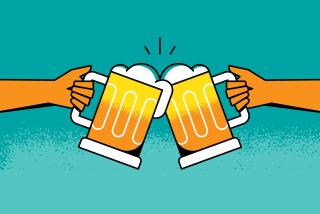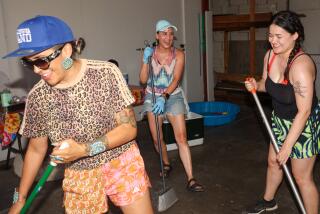Bar None : Center in Country Club Park Gives Minority Gays the Freedom to Meet Without Being Harassed : JEWEL THAIS-WILLIAMS
I didnât come into this business with the idea of it becoming a community center. It started before AIDS and the riots and all that. I got the first sense of the business being more than just a bar and having an obligation to the community years ago when black gays were carded--requiring several pieces of ID--to get into white clubs. I went to bat for them, though I would love to have them come to my place every night.
The idea is to have the freedom to go where you want to without being harassed. The predominantly male, white gay community has its set of prejudices. Itâs better now but it still exists.
Iâve never considered myself an activist--the word doesnât seem to apply to me. Iâm more of a person who has a social conscience. Iâm concerned about some people not being able to experience in this democracy with the kind of freedom everyone is suppose to have.
I, for one, feel very responsible for making sure thereâs AIDS education available, making sure folks know weâre all in this fight and itâs real. We have to be willing to make changes, and as a result of the emphasis being off of âpicking upâ or âcatching one,â which was the reason I named my place Catch One, thereâs more emphasis on creating real friendships and real relationships.
The bar is almost the least of everything that goes on here, itâs more a community center. That aspect of it being a bar where people can come and dance and socialize and have fun is necessary. But in the 1990s, a bar has to offer more than just a place to socialize.
When I came into this business, it was with the idea it would be recession-proof. It isnât. I time the big drop in business to when Magic announced he had the AIDS virus. I think what it said was that âyou can get it too.â A lot of people were still acting like they were still in the â70s and â80s--all that sexual freedom. They didnât believe they could get AIDS. Bisexuals are really at risk also. There are so many closet bisexuals who think just because theyâre not effeminate or donât do this or that it means theyâre not bisexual.
The statistics have proven that in child-bearing age, 15 to 45, itâs (one of the leading causes of deaths) of African-American women. A lot of it has to do with socioeconomic status--that translates into not being aware, more drug use per capita, more prostitution per capita, more relationships with bisexual men. There are a lot of gay and bisexual black men. Especially on the West Coast, thatâs the primary way women are getting the disease. On the East Coast itâs I.V. drug users.
I got into doing AIDS work through the Minority AIDS Project. Bishop Carl Bean, an openly gay man, approached me to help found it, and we also got the Unity Fellowship Church of Christ off the ground. Itâs a predominantly black, gay church, and it was the first of its kind here. When it started in 1985, it met at Catch One on Sundays, and was made up predominantly of people from here. Now itâs on Jefferson, two blocks east of La Brea. The purpose of getting it together was to serve the minority gay community. Some of us members didnât go to any other church before Unity began.
I met my spouse, Rue Thais, at Unity. That led to my next involvement with AIDS work. Rue and I started Rueâs House, a shelter for women and children with AIDS, in Central Los Angeles. Thereâve been numerous women and children who have lived at the shelter since it opened in 1989. Theyâre mostly minority women and children but they donât turn away anyone because of race. Generally they have full-blown AIDS by the time they get there. All of them are homeless.
Rueâs House was the first of its type in the nation. Rue had been a battered woman, lived in a shelter and subsequently worked in one. Rue and some others sheâs working with are trying to start an agency to secure placement for kids whose mothers are dying of AIDS.
In 1990, I was invited to join the board of governors, then the board of directors of AIDS Project Los Angeles. I wouldnât have gone to the board if I didnât think Iâd be able to help facilitate establishing a positive relationship between APLA and the black community.
Education is the key to not getting AIDS, and I think too many African-Americans have the feeling of hopelessness and a lack of self-esteem. They say: âSo what if I get it? What if I do die? It might be the best way out.â I say: âDonât give up.â
I was fortunate to find a 12-step program myself. The cycle of hopelessness can be broken by putting yourself out there for others. But you canât help other people unless you help yourself. You have to want for yourself too. Since the riots, Iâve seen more of this helping your brother and sister attitude--and itâs not only blacks with blacks but others. I hope it continues. Itâs the key to our survival.
Neighborhoods that were once predominantly African-American have seen their power base eroded. Weâve scattered, been weakened by the community and law enforcement allowing certain things to happen to those communities--in addition to drugs . . . gangs . . . immigrants. Some of us who can, take flight, because weâre concerned with our safety, our childrenâs lives. So the power base in the inner city that was once African-American here is no longer as great a force.
In 1985, my club was burned. The Fire Department took its time about coming. I overheard one of the firemen say, âWe should just let it burn down.â Fortunately, there were breaks and fire walls and it didnât burn down. The main ballroom did burn and it would take two years to reopen. There was never any investigation of the arson. Thatâs what was going on in the area then.
A lot of black businesses were burned and/or bought out at high prices at that time so it was tempting to sell. Now, Iâm the only African-American business owner left that I know of in this immediate area that is predominantly Koreatown. I told everybody, from the Fire Department to the folks at Building and Safety, that I was not going anywhere.
Itâs very important not to give up our institutions--places of business that have been around for years. Having a business that people can see can offer them some incentive to do it for themselves. Iâm determined to win, and if I do fail or move on, I want my business to go to black people who have the same interest that I have to maintain an economic presence in this community.


